  |
|
October 6, 2022 |
 With the traditional ringing of the bell we bring this meeting to order!
With the traditional ringing of the bell we bring this meeting to order!
Club member's attendance is recorded by logging in.
Visiting Rotarians may complete a makeup form at the end of this meeting; YOUR donation for making up with us helps fund our service projects!
Visitors are always welcome to browse and register without obligation.
Our club offers the flexibility of ROTARY ON YOUR TIME!
and an opportunity to remain connected with Rotary!

Welcome to this week’s meeting of the eClub of the State of Jefferson.
I am Bob Gibson, President of the Rotary eClub of State of Jefferson. Welcome to this week’s meeting. I hope this finds you well and enjoying the transition into the autumn.
A couple of weeks ago, Rotary International President Jennifer Jones announced a pledge of $150 million to the effort to eradicate polio. We are so very close to achieving the Rotary goal that started with the creation of PolioPlus in 1985. The October edition of the Rotarian has an in-depth article on the development of a modified polio vaccine that will target the vaccine-derived infections that have been an obstacle to eradication. Currently, polio is endemic in two countries, Afghanistan, and Pakistan.
I have set a club goal for our PolioPlus contributions at $3,000 for this Rotary year. Rotarians have shown a continued commitment to get this job done. Rotary has been a central organization in the effort for over three decades. Backing off now is not an option. Polio is incurable, and it can be prevented. As you think about your philanthropic contributions for this year, I urge you to consider PolioPlus.
Thank you for your interest in our Club and your commitment to “Service above Self.”
Enjoy the meeting.
If you have any questions or comments, I am available. My e-mail address is: bob@bluewaterphoto.net.
email president@StateOfJeffersonRotary.org

Call for Volunteers
District 5110 has a long history of outstanding leadership development and volunteer commitment at the international, zone, district, and club levels. This year, we have an opportunity to reorganize and revitalize the District Training Team. The goal is to create a team of 5 to 10 Rotarians, with a District Trainer or Training Team Chair. The commitment is for one year, with the hope that each member will be willing to continue in the role for another year or two or more as continuity is desired. The District Trainer is a member of the District Leadership Team and the District’s representative to the Pacific Northwest PETS training committee. The Trainer/Chair position is targeted to be a three-year term. The team will assist in establishing the curriculum for the annual Pre-PETS training, the elements for the Club Training Assembly and various other leadership training opportunities that become available. A description of the roles are available if requested.
Please send your name and contact information to DGE Jim (dgjim2324@gmail.com) at any time if you are willing to assist providing the best training curriculum to our current and future Club Presidents. You may also provide the name and/or contact information for individuals that may have interest in serving the Rotary family in this manner.
Paul Harris Dinner and TRF Workshops - October 14, 2022
You are invited to attend The Paul Harris Dinner in celebration of the Rotary Foundation on the evening of October 14, 2022. Let's gather again to share fellowship, fabulous food, and hear stories of the Rotary Foundation's great service around the globe.
The Paul Harris Dinner & TRF Workshops
Please join us to celebrate the Rotary Foundation in the spirit and style of our Rotary Founder, Paul Harris. Join us for specialty drinks and an incredible dinner menu followed by inspirational speakers. Come hear our guest speaker, PDG Savi Bhim, a Foundation Story Teller from Simi Sunrise Rotary Club, share her personal stories about the Rotary Foundation’s service to the world. Do not miss this opportunity to help us honor and recognize our recent Major Donors, listen to DG Candidate Speeches, and enjoy Fellowship with your Rotary friends. Semi-formal early 1900’s attire and costumes are encouraged!
Location:
The Shedd Institute, 868 High Street, Eugene, OR 97401, Room – The Warren Court
The Paul Harris Dinner cost is $60.00 per person all-inclusive.
Plated Dinner: Includes one Specialty Cocktail, Hors d ’Oeuvres, Seasonal Salad, Main Course, and Dessert. No-Host Bar also opens during the event.
Complimentary Red and White Wine served during dinner.
Friday Afternoon Workshop Sign-Up (at the Graduate Hotel):
Tell Your Story with Savi Bhim (1:30 PM) cost is $0.
Ten Ways to Inspire Giving to the Rotary Foundation with DGN Nelson Maler (2:30 PM) cost is $0.
Reserve a room at The Graduate Hotel Eugene. A block of 20 rooms has a special Rotary rate of $159.00 not including fees and taxes. Awaiting a link to this special rate. Please come back to your registration soon for more information
Click Register NOW for Paul Harris Dinner
2nd Quarterly Grants Meeting - October 15th
Please SAVE THE DATE of October 15th, Saturday, 9a-12pm, for the 2nd Quarter Grants Meeting. This meeting will be a hybrid format (at your request).
You can attend in person or via Zoom. YOU MUST REGISTER AND INDICATE HOW YOU WILL BE PARTICIPATING.
We are providing a continental breakfast and lunch free of charge, so I need an accurate meal count please.
The location will be in First Avenue Learning Center located at 1470 West First Avenue @ The Eugene Mission.
Register NOW for 2nd Quarterly Grants Meeting
October is Economic and Community Development Month
 Nearly 1.4 billion employed people live on less than $1.25 a day. Our members promote economic and community development and reduce poverty in underserved communities through training, well-paying jobs, and access to financial management institutions. Projects range from providing people with equipment to vocational training. Our members work to strengthen local entrepreneurs and community leaders, particularly women, in impoverished communities.
Nearly 1.4 billion employed people live on less than $1.25 a day. Our members promote economic and community development and reduce poverty in underserved communities through training, well-paying jobs, and access to financial management institutions. Projects range from providing people with equipment to vocational training. Our members work to strengthen local entrepreneurs and community leaders, particularly women, in impoverished communities.Join Rotary and help grow local economies around the world.
Give now to promote economic growth in communities.
Read news about Rotary's work to grow local economies
- Rick Burns' thoughtful approach to Iraq and Afghanistan
- Rise of the female Honduran entrepreneur
- New Ugandan club takes on challenges of a growing economy
- Free vegetable gardens sprouting up around France
Resources & reference
- Read Economic and Community Development Project Strategies, a guide for economic and community development projects
- Browse Rotary Showcase for member projects that help grow local economies
- Find a project to sponsor on Rotary Ideas
- Contact our manager for economic and community development
Ending racism, building peace
By Geoffrey Diesel and Kathy Doherty, co-founders of the Racial Equity Project
 The two of us met as Rotary Peace Fellows during the inaugural cohort of Peace Activators in North America. We made a commitment to provide training, education, and support to the Rotary family on the framework of Positive Peace. The initiative grew out of Rotary’s strategic partnership with the Institute for Economics and Peace (IEP), a global think tank dedicated to measuring Positive Peace defined as the “attitudes, institutions, and structures that uphold peaceful societies.”
The two of us met as Rotary Peace Fellows during the inaugural cohort of Peace Activators in North America. We made a commitment to provide training, education, and support to the Rotary family on the framework of Positive Peace. The initiative grew out of Rotary’s strategic partnership with the Institute for Economics and Peace (IEP), a global think tank dedicated to measuring Positive Peace defined as the “attitudes, institutions, and structures that uphold peaceful societies.”
Peace activators in the US were already addressing racism in this country, but the murder of George Floyd in 2020 served as catalyst for further action. In October of that year, we co-founded the Racial Equity Project (REP), a subcommittee of peace activators in North America, committed to studying ways to create a more peaceful society through antiracism.
“End Racism. Build Peace” is the focus of this year’s United Nation’s International Day of Peace on 21 September. We are grateful for the work Rotary International is doing in Diversity, Equity, and Inclusion (DEI) by creating a DEI Task Force in September 2020. In 2022, the Task Force strengthened Rotary’s 2019 DEI statement supporting a more comprehensive commitment to diversity, equity, and inclusion. In addition, Rotary is using IEP’s eight Pillars of Positive Peace framework to foster equity for people of all races, religions, genders, and abilities. This is being done through community service projects applying Rotary’s areas of focus to strengthen those pillars.
The eight pillars must function both individually and in unison to effectively sustain positive peace. Racism is a form of violence that manifests as both direct and structural violence. We believe achieving racial equity requires sustained commitments across all of the eight pillars. To illustrate how we apply the Acceptance of the Rights of Others pillar to racism, The Racial Equity Project developed an infographic that demonstrates our research on the impact of racial inequity in the United States (where REP is based).
Our research on the disparities between Black and white Americans led us to further examine our systems and their relationship to these inequities. Since the areas of focus and the eight Pillars of Positive Peace are essential to peacebuilding, we took a deeper look into how these models could better intersect with DEI and peacebuilding to address racism.
For example, what does it really mean to be diverse? Not only racially, but ethnically, by gender, class, and ability? Are we creating a true sense of belonging not only in our Rotary communities, but in our communities at large, both locally and globally? Are we including communities impacted by our service projects in the decision-making processes? Are we truly fostering equity, or are members of our communities being moved to the margins? And if so, how do we disrupt the status quo and create access and equity for those who are marginalized?
Achieving racial equity cannot be separate from the notion and implementation of Positive Peace. So how can the Rotary community influence this? This is difficult work, but it is our work.
We can start by becoming more informed and taking action to end racism. The eXtension Foundation Impact Collaborative states, “Tackling equity issues requires an understanding of the root causes of outcome disparities within our society.” To change something, we need to understand it.
Let’s ask more questions and consider the implications of structural racism in our communities. Let’s make this a lifelong learning process, central to our service in Rotary, creating more equitable access, opportunities, and outcomes for all.
Geoffrey Diesel and Kathy Doherty completed their Rotary Peace Fellowships at Chulalongkorn University, Bangkok, Thailand. They and the Racial Equity Project team have worked with a number of Rotary clubs, providing training and presentations on Positive Peace and racial justice at a variety of levels including presidents-elect training seminars, the Rotary International DEI Task Force listening tour, and Toxic Polarization training for senior Rotary leaders.
To learn more about positive peace, enroll in the Rotary Positive Peace Academy course.

Sign Up for the Benefits of Rotary's Biz Network
By Mike Corwin
One of the great benefits of Rotary is to be surrounded by people who have integrity, are leaders, respect diversity, are wonderful friends, and are dedicated to serving others in need. Well, wouldn’t you also want to do business with one of those grand associates?
 Sign up now with ONE CLICK and reap the many benefits including:
Sign up now with ONE CLICK and reap the many benefits including:
- Finding and doing business with like-minded professionals
- A platform to advertise your business
- Promotion of your business events and list special offers.
- Connect your listing through social media platforms including Facebook, Instagram and LinkedIn.
- A portion of the funds generated from this program are used to support important service work in our local communities.
- Using vocation and friendship as an opportunity to serve others in need.
- You will receive a Rotary Business Network plaque to showcase in your place of business.
- Potential to have your business spotlighted and honored in this District eNews!
So join us, sign up today a Rotary Business Network registration. PDGs Cindi O’Neil and Bill Grile have remained steadfast and dedicated to networking Rotarians who love doing business with other Rotarians! Click here for their letter of endorsement.
Visit the Rotary Business Directory if you have questions.
![]()
What does it mean when polio virus is detected in the sewage of a city? Dr Zubair Wadood explains what it will take to eradicate polio from the planet in Science in 5. Thanks to eClub Rotarian Carol F. for suggesting this article
WHO's Science in 5 - Is poliovirus making a comeback?
24 October is World Polio Day!
As World Polio Day approaches, we’re getting ready to amplify our message about eradicating polio to protect the world’s children from this devastating disease.
We’ve made tremendous progress so far, and now’s the time to intensify our fight to make polio the second human disease ever to be eradicated. In 2020, the World Health Organization’s African region was certified free of wild poliovirus, showing that eradication is possible even in very difficult circumstances.
The wild poliovirus remains endemic in just two countries — Afghanistan and Pakistan— but as long as polio exists anywhere, it remains a threat everywhere. So let’s use World Polio Day to advocate for the support we need to end polio in countries where children are still as risk.
Get involved
Take action this World Polio Day by hosting virtual and community events, creating fundraisers, and sharing posts about the importance of polio eradication on social media.
Use the World Polio Day Toolkit to find resources and tips for planning activities and promoting a polio-free world.
Download the World Polio Day Toolkit

District Literacy Action Grant
DISTRICT 5110 ACTION AWARDS PROGRAM
Literacy Fund $500
 The Chinle Plants Hope Community Project is currently putting together a bookmobile to reach isolated school-age children throughout the Chinle, Arizona Chapter of the Navajo Nation. Part of this effort is bringing internet service to these children so that they can have access to learning activities online. In order to accomplish this, a satellite dish is required. The District Action Grant monies will be used to purchase the dish and Rotarians will install it.
The Chinle Plants Hope Community Project is currently putting together a bookmobile to reach isolated school-age children throughout the Chinle, Arizona Chapter of the Navajo Nation. Part of this effort is bringing internet service to these children so that they can have access to learning activities online. In order to accomplish this, a satellite dish is required. The District Action Grant monies will be used to purchase the dish and Rotarians will install it.
The Starlink internet dish, mounted on the Bookmobile, purchased through Starlink directly costs around $600.
Thanks to eClub Rotarians John A. for research, Jean H. for writing and submitting the grant request, and John C for a $1,000 donation to the eClub foundation.

![]()
Todd Hagan and his wife ventured outside their home in Switzerland County, Ind., once the seemingly endless torrential downpour subsided. They were stunned by what they saw. The wooden bridge connecting one side of their driveway to the other — their only access to a main road — was destroyed by flash flooding that hit southeastern Indiana on Sept. 3. Switzerland County was inundated with roughly eight inches of rain, damaging homes, roads, and killing one person. “The water just destroyed this bridge,” said Hagan, 59, whose grandson lives with them. “I was blown away.” Hagan felt lucky that it was only his bridge — which hovers over a creek — that was destroyed by the flooding, he said. “We’re alive, and we’ll get through it,” he assured his wife Sarah. But the couple felt somewhat stranded, as they had no way of getting their vehicle over the bridge and into town. Aside from a four-wheeler path on their property that leads to their neighbor’s house, they were stuck. “Everybody knows everybody around here,” Hagan said of his hometown, adding that people quickly heard about his predicament. Ryan Jesop, his grandson’s football coach, was one of the first to reach out. Jesop, an eighth-grade teacher at Switzerland County Middle School, decided to rally his football team to rebuild the bridge. “As soon as I heard they needed help, I put out a call,” Jesop said, adding he estimated that if the couple fixed it themselves, it could take a month or more. Since the bridge is on private property, the couple was responsible for repairing it on their own. “This may be the most labor you guys ever do on Labor Day,” Jesop told his team. As Jesop anticipated, the players agreed to meet the following morning on Sept. 5, ready to rebuild the bridge. Many of the boys brought along their parents and siblings, as well as other members of the community, including a few Cub Scouts. “Everybody showed up with good attitudes and were ready to help in any way that they could,” said Gabe Rose, 16, who showed up with his father. “My dad pretty much said, ‘Well, if I’m going to take you there, I might as well stick around and help.’ ” About 30 people congregated on their property before 9 a.m., “both of us were just speechless,” Hagan said. “Tears were coming out of our eyes.” “I didn’t expect anything,” he continued. “The outreach of people was just mind-boggling.” The base structure of the bridge is a steel frame supported by concrete pillars — neither of which were damaged by the flooding, Hagan said. The damaged wooden planks that covered the 60-foot bridge, however, needed to be replaced. It was no small job. Another coach at the school, Kevin Steuart, volunteered to pick up a load of fresh lumber — which Hagan had ordered in advance — and the football players brought tools and supplies from home. They immediately got to work, forming an assembly line of sorts. “We had to tear it all down and get all the debris off,” Hagan said. “It was like a factory.” “The adults were the only ones allowed on the bridge to take apart the old boards,” Jesop added. Meanwhile, the boys collected the damaged boards and threw them on Hagan’s trailer, which he used to haul the discarded wood to a burning pile. Then, they sawed the fresh lumber to the proper size, and parents nailed the new pieces in place until the bridge was covered. “I think everybody was pretty surprised by how well we worked together,” said Rose, a sophomore student. “There was a team atmosphere with our parents, and it felt like it brought us together even more.” The all-hands-on-deck effort made a seemingly strenuous task far more manageable. “The next thing I know, the bridge was done,” Hagan said. “It was just amazing.” A job that would have taken him and his wife several weeks to complete took less than three hours. “I couldn’t be more thankful,” Hagan said. The football players and their families said the deviation from typical Labor Day festivities turned out to be memorable — and fulfilling. “It felt really rewarding,” said Gavin Reese, 18, a senior student. “We all came together to help a family in need.” For Jesop and his team, the decision to help the Hagans was a no-brainer, he said, especially given the couple’s dedication to supporting others. “They have always stepped up to volunteer,” said Jesop, explaining that amid a bus driver shortage, Hagan — who works at the local post office — got his license to drive a school bus in his spare time. The couple has also fostered close to 50 children in the past two years. “They’re amazing people,” Jesop said. “They’re the heroes, not the football players.” In any case, Hagan — who wrote thank-you cards to the students and made a donation to the team — was touched that they were willing to put aside their plans to be there. “I was very moved,” he said. “If somebody goes down, our community is there to pick them up.” 






![]()
One of the biggest, most dominant corporations in history operated long before the emergence of tech giants like Apple or Google or Amazon. The English East India Company was incorporated by royal charter on December 31, 1600 and went on to act as a part-trade organization, part-nation-state and reap vast profits from overseas trade with India, China, Persia and Indonesia for more than two centuries. Its business flooded England with affordable tea, cotton textiles and spices, and richly rewarded its London investors with returns as high as 30 percent. “At its peak, the English East India Company was by far the largest corporation of its kind,” says Emily Erikson, a sociology professor at Yale University and author of Between Monopoly and Free Trade: The English East India Company. “It was also larger than several nations. It was essentially the de facto emperor of large portions of India, which was one of the most productive economies in the world at that point.” But just when the East India Company’s grip on trade weakened in the late 18th century, it found a new calling as an empire-builder. At one point, this mega corporation commanded a private army of 260,000 soldiers, twice the size of the standing British army. That kind of manpower was more than enough to scare off the remaining competition, conquer territory and coerce Indian rulers into one-sided contracts that granted the Company lucrative taxation powers. Without the East India Company, there would be no imperial British Raj in India in the 19th and 20th centuries. And the wild success of the world’s first multinational corporation helped shape the modern global economy, for better or worse. On the very last day of 1600, Queen Elizabeth I granted a charter to a group of London merchants for exclusive overseas trading rights with the East Indies, a massive swath of the globe extending from Africa’s Cape of Good Hope eastward to Cape Horn in South America. The new English East India Company was a monopoly in the sense that no other British subjects could legally trade in that territory, but it faced stiff competition from the Spanish and Portuguese, who already had trading outposts in India, and also the Dutch East Indies Company, founded in 1602. England, like the rest of Western Europe, had an appetite for exotic Eastern goods like spices, textiles and jewelry. But sea voyages to the East Indies were tremendously risky ventures that included armed clashes with rival traders and deadly diseases like scurvy. The mortality rate for an employee of the East India Company was a shocking 30 percent, says Erikson. The monopoly granted by the royal charter at least protected the London merchants against domestic competition while also guaranteeing a kickback for the Crown, which was in desperate need of funds. Many of the hallmarks of the modern corporation were first popularized by the East India Company. For example, the Company was the largest and longest-lasting joint stock company of its day, which means that it raised and pooled capital by selling shares to the public. It was governed by a president, but also a “board of control” or “board of officers.” Unlike today’s relatively staid corporate board meetings, the East India Company’s meetings were raucous affairs attended by hundreds of stockholders. And while the East India Company charter granted it an ostensible monopoly in India, the Company also allowed its employees to engage in private trading on the side. At first, the Company didn’t have a lot of money to pay its employees for this highly dangerous work, so it needed to provide other incentives. “That incentive was to trade for their own private interest overseas,” says Erikson. “Employees of the East India Company would trade both within and outside of the rules that the Company granted. There were so many opportunities to fudge, cheat and smuggle. Think about jewelry, which is a very small and very expensive thing that you can hide on yourself easily.” Before the East India Company, most clothes in England were made out of wool and designed for durability, not fashion. But that began to change as British markets were flooded with inexpensive, beautifully woven cotton textiles from India, where each region of the country produced cloth in different colors and patterns. When a new pattern arrived, it would suddenly become all the rage on the streets of London. “There’s this possibility of being ‘in the right style’ that hadn’t existed before,” says Erikson. “A lot of historians think this is the beginning of consumer culture in England. Once they brought over the cotton goods, it introduced this new volatility in what was popular.” When the British and other European traders arrived in India, they had to curry favor with local rulers and kings, including the powerful Mughul Empire that extended across India. Even though the East India Company was technically a private venture, its royal charter and battle-ready employees gave it political weight. Indian rulers invited local Company bosses to court, extracted bribes from them, and recruited the Company’s muscle in regional warfare, sometimes against French or Dutch trading companies. The Mughul Empire concentrated its power in the interior of India, leaving coastal cities more open to foreign influence. From the start, one of the reasons the East India Company needed so much pooled capital was to capture and build fortified trading outposts in port cities like Bombay, Madras and Calcutta. When the Mughul Empire collapsed in the 18th century, war broke out in the interior, driving more Indian merchants to these company-run coastal “mini kingdoms.” (Photo - English, Dutch and Danish factories at Mocha By Olfert Dapper - eBay.com, Public Domain) “The problem was, how would the East India Company rule these territories and by what principle?” says Tirthankar Roy, a professor of economic history at the London School of Economics and author of The East India Company: The World’s Most Powerful Corporation. “A company is not a state. A company ruling in the name of the Crown cannot happen without the Crown’s consent. Sovereignty became a big problem. In whose name will the company devise laws?” The answer, in most cases, was the East India Company’s local branch officer. The London office of the company didn’t concern itself with Indian politics. Roy says that as long as trade continued, the Board was happy and didn’t interfere. Since there was very little communication between London and the branch offices (a letter took three months each way) it was left to the branch officer to write the laws governing company cities like Bombay, Madras and Calcutta, and to create local police forces and justice systems. This would be the equivalent of Exxon Mobil drilling for oil in coastal Mexico, taking over a major Mexican city using private armed guards, and then electing a corporate middle manager as the mayor, judge and executioner. A major turning point in the East India Company’s transformation from a profitable trading company into a full-fledged empire came after the Battle of Plassey in 1757. The battle pitted 50,000 Indian soldiers under the Nawab of Bengal against just 3,000 Company men. The Nawab was angry with the Company for skirting taxes. But what the Nawab didn’t know was that the East India Company’s military leader in Bengal, Robert Clive, had struck a backroom deal with Indian bankers so that most of the Indian army refused to fight at Plassey. Clive’s victory gave the East India Company broad taxation powers in Bengal, then one of the richest provinces in India. Clive plundered the Nawab’s treasure and shipped it back to London (keeping plenty for himself, of course). Erikson sees the East India Company’s actions in Bengal as a seismic shift in its corporate mission. “This completely changes the Company’s business model from one that had been focused on profitable trade to one that focused on tax collection,” says Erikson. “That’s when it became a really damaging institution, in my opinion.” In 1784, the British Parliament passed Prime Minister William Pitt’s “India Act,” which formally included the British government in ruling over the East India Company’s land holdings in India. “When this act came into being, the Company ceased to be a very significant trade power or a significant governing power in India,” says Roy. “The proper British Empire took hold.” The exploits of the East India Company didn’t end in India. In one of its darkest chapters, the Company smuggled opium into China in exchange for the country’s most prized trade good: tea. China only traded tea for silver, but that was hard to come by in England, so the Company flouted China’s opium ban through a black market of Indian opium growers and smugglers. As tea flowed into London, the Company’s investors grew rich and millions of Chinese men wasted away in opium dens. When China cracked down on the opium trade, the British government sent warships, triggering the Opium War of 1840. The humiliating Chinese defeat handed the British control of Hong Kong, but the conflict shed further light on the East India Company’s dark dealings in the name of profit. By the mid-19th century, opposition to the East India Company’s monopoly status reached a fever pitch in Parliament fueled by the free-market arguments of Adam Smith. Erikson says that ultimately, the death of the East India Company in the 1870s was less about moral outrage over corporate corruption (of which there was plenty), but more about English politicians and businessmen realizing that they could make even more money trading with partners who were on a stronger economic footing, not captive patrons of a corporate state. Even though the East India Company dissolved more than a century ago, its influence as a ruthless corporate pioneer has shaped the way modern business is conducted in a global economy. “It’s hard to understand the global political structure without understanding the role of the Company,” says Erikson. “I don’t think we’d have a global capitalist economic system that looks the way it does if England hadn’t become so uniquely powerful at this point in history. They transitioned into a modern industrial force and exported their vision of production and governance to the rest of the world, including North America. It’s the cornerstone of the modern liberal global political order.”How the East India Company Became the World's Most Powerful Monopoly
East India Company Founded Under Queen Elizabeth I

East Indies Trade Fueled Consumer Culture
In India, Trade and Politics Blend

From Mercantile Company to Empire Building
The Opium Wars and the End of the East India Company
By Ed Tittel Computerworld When things go wrong with Windows, as they sometimes will, nothing ensures a faster or easier return to normal than restoring a recent image backup. To that end, I back up my production PCs at 9 a.m. every day. That means that I’ll never lose more than a day’s work if something should go badly enough wrong to force that day’s image backup to be restored. In the sections that follow, I explain what all this means, how it works, and why you shouldn’t use built-in backup in either Windows 10 or 11. Finally, I’ll walk you through how to use my favorite free image backup tool while recommending a couple of other acceptable alternatives. Simply put, an image backup is a snapshot of the complete contents of all partitions on a computer’s C: drive. In other words, it’s an exact copy (“image”) of the drive — operating system, data files, settings, and all — not just the files stored on it. Image backups are sometimes called system image backups, whole-system backups, full system backups, or other variations on that theme. If you look at the disk layout for a typical C: drive, you’ll see that it usually includes four or more partitions, as shown in Figure 1. Figure 1: The default Windows 10 and 11 disk layout comprises 4 partitions: (1) EFI, (2) MSR, (3) Windows OS, and (4) Windows Recovery Environment (WinRE). (Click image to enlarge it.) (Please note: I use the excellent, no-cost MiniTool Partition Wizard Free instead of Windows’ built-in Disk Management tool because Partition Wizard shows the Microsoft Reserved, or MSR, partition along with other partitions on the C: drive; in Figure 1 it occupies 16MB in position 2.) When you make an image backup, all the bits and bytes for each partition are captured. And when an image backup is restored, the previous contents of the drive are overwritten, as the image for each partition is written to the target drive afresh and anew. Making an image backup involves making a snapshot of the contents of each partition on one drive and storing those contents within an image copy for each partition on another drive. TechTerms.com describes a disk image as “a software copy of a physical disk” that “saves the entire data from the disk, including the file structure and folders from the disk, in a single file.” Thus, each partition is captured in its own image file. Given the right software, in fact (I’ll show a demonstration later on in this story), you can explore an image just as if it were a standalone file system. To create an image, special software is used to build the single file (or collection of files) that represent the whole disk or its constituent partitions. Disk image files are often stored using special binary formats. Thus, for example, the .ISO image format (a CD- or DVD-oriented disk image format based on the ISO-9660 standard, which Microsoft uses to distribute images of the Windows installation environment) contains an exact duplicate of a disk image, including data saved in files on that disk, as well as file system information and related metadata. In Windows 7, Microsoft built a Backup and Restore utility into the OS. It’s still present in Windows 10 and 11 (shown in Figure 2 at the top of the Control Panel window), but it’s currently called “Backup and Restore (Windows 7),” which provides an important clue about its status. Figure 2: While the Backup and Restore (Windows 7) utility is still around, there are much better options. Microsoft has clearly backed away from the tool. The company’s current “Backup and Restore in Windows” support article mentions the Backup and Restore (Windows 7) utility only in the context of restoring from system image backups created “in previous versions of Windows.” Having followed ongoing backup and restore discussions on Windows Ten Forums since October 2014, and on Windows Eleven Forum since June 2021, I can say that none of the participants speak in favor of using the tool any longer. In fact, most Windows gurus recommend using something else because of occasional (but credible) reports of problems when restoring images made using the Backup and Restore (Windows 7) tool. Fortunately, there are better options available. There are at least three workable, respectable, and highly regarded free Windows backup tools that work with both Windows 10 and Windows 11: All three tools make compact, speedy, and reliable image backups of Windows 10 and Windows 11 PCs. I have been a devoted user of Macrium Reflect Free for a decade now, and present its use on Windows 11 in the following screenshots as an illustration of how such programs work. (Your mileage may vary, depending on which tool you choose.) Macrium provides a left-column menu entry under the “Create backups” tab that reads “Create an image of the partition(s) required to backup and restore Windows.” Though there are many other options and capabilities in the program, this is exactly what’s needed here, so I’ll step you through working with this facility. Upon clicking the entry, a map of the Windows (C:) drive appears with two of the four partitions checked, as shown in Figure 3. I recommend checking all four partitions before proceeding. Figure 3: By default, only the EFI (#1) and Windows (#3) partitions are checked. I recommend checking all four. (Click image to enlarge it.) The Destination folder shows where backups will reside. On my Windows 11 test machine, that’s E:\MRBack\. The first time you use this program, you must target some drive different from C: and specify a “home directory” for your backups. The best target for backups, in fact, is an external drive (usually USB); if a system goes really south, you can use the external drive to restore things to a different PC more easily. Click Next > (at lower right) to move to the next screen. This calls up the “Backup Plan” window, wherein you can specify some kind of backup plan (called a “Template” in the program), as shown in the choices visible in the pull-down menu in Figure 4. Figure 4: Macrium Reflect offers a well-documented collection of six different backup plans. (Click image to enlarge it.) The most inclusive backup plan is shown at the top of the list and features a full backup each month, plus daily differential backups (everything changed since the previous day) and incremental backups (anything new or changing) every 15 minutes all the time. This offers the best overall protection but requires at least 100-200GB of disk space (more is better) for best results. Figure 5 shows plan settings should you pick the Intra-Daily Backup Set as your plan, recommended for those looking to obtain maximum data protection, with a big (and relatively empty) drive on which to back up. Macrium Reflect lets you edit the default backup schedule and number of backups saved for the plan. (Note: my backup drive on this PC offers a nominal 5TB capacity that File Explorer reports as 4.54 TB actual capacity.) Figure 5: The Intra-Daily Backup Set properly describes incremental backups as “Stealth,” because they’re missing from the retention rules (too many to track and log, in fact). (Click image to enlarge it.) When you click Next > at the bottom of the Backup Plan window, Reflect presents a disk image screen that shows you the options you’ve selected (see Figure 6). Notice that the “Total Selected” size for each image is 69.29 GB; because the program uses sophisticated and capable compression, each resulting full backup snapshot is actually 35GB in size. (Differential and incremental backups seldom amount to 10% of that number, though this will vary based on file activity and changes.) Figure 6: The “Disk Image” pane stores the details that describe the backup’s schedule and types. (Click image to enlarge it.) Click Finish to complete the backup description process. Then you’ll be presented with a pane that provides options to “Run this backup now” and “Save as an XML Backup Definition File” what you’ve just defined. (Both options are selected by default, as shown in Figure 7.) To fire off your first such backup, click OK. Figure 7: I named this XML file “IntraDaily.xml” and left the boxes checked. You could do likewise. Once the OK button is clicked, the first full backup runs. On my test system, that took about 6 minutes in all. Note further that the on-disk size of the backup is 31.85GB (more than 50% compression). Figure 8 shows the results from the first full backup run. Figure 8: First full backup results took 6:14 and consumed 31.85GB disk space. (Click image to enlarge it.) One of my reasons for sticking with Reflect is its speed: to the best of my knowledge neither of the other two programs I mentioned earlier is quite as fast. Because it runs in the background on reasonably fast PCs, I hardly ever notice it’s working, which is just what you want in a backup program. Should you ever need to restore an image backup, it’s an easy thing to do. Typical reasons range from the sublime (such as OS corruption, driver failures, boot manager problems, malware attacks) to the ridiculous (accidentally deleted key OS files to make a system unusable). Though Macrium Reflect (and the other programs cited earlier) offer program menu-based restore functions that are easy to use, when a restore is needed, I often find myself turning to the program’s Rescue Media. It is bootable, and smart enough to let you point to the backup image you wish to restore quickly and easily. For me, that usually means the most recent backup before things started going south. The built-in Restore menu works almost exactly like the restore function available from Reflect’s Rescue Media boot-up. A pop-up menu item that appears when you click Restore in the program menu reads “Browse for an image or backup file to restore,” as shown in Figure 9. That’s the one you want. Figure 9: Click the top menu item shown to browse a list of available backups. (Click image to enlarge it.) It is important to know the drive letter for your image backups and the name of the folder where they’re stored. On my test PC, I know that’s Drive E: in the MRBack (short for Macrium Reflect Backup) folder, where such backups take an .mrimg (Macrium Reflect image file) extension. There the latest backup is easily identified by its timestamp, as shown in Figure 10. THAT’s the one I would want to restore. Figure 10: Select the backup you want, then click the Open button at lower right to start the restore process. (Click image to enlarge it.) Simply click the Open button to get that process underway: Macrium Reflect does the rest. Macrium Reflect (and the other programs) also offer file- or folder-based restore capabilities. To use them, you’d click the “Explore image” item shown in the number 2 position in Figure 9. This opens a File Explorer-like interface that lets you designate which image you wish to explore, then select files and/or folders within that image to restore to the current running Windows image. It’s just like copying files and folders, which I assume readers can handle without step-by-step instructions, so I’ll skip those details here. For the incurably curious, see the MR knowledge base article “Restoring a file and folder backup” for more information. My own choice is Macrium Reflect. You can pick any of the options I’ve presented here as you see fit. For speed’s sake, you may want to consider targeting a fast drive (ideally an NVMe PCIe-x4 SSD) on which your backup images will reside. But the important thing is to back up regularly and often. That’s your best guarantee to minimize data loss if and when the time ever comes to restore a backup. Better to not need it and still have a backup than to need one and have none. How to make a Windows 10 or 11 image backup
Making a full system image backup preserves not only your files, but Windows and all its settings as well. Here are the best free Windows backup and recovery tools with step-by-step instructions.
What is an image backup, anyway?
 IDG
IDG How image backup works
Don’t use the built-in Windows backup utility
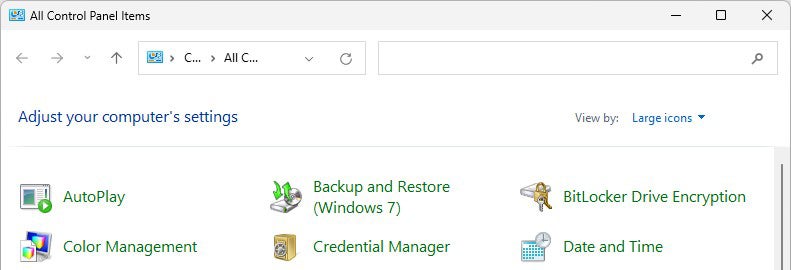 IDG
IDG Back up and restore Windows with third-party backup tools
Create (and schedule) image backups
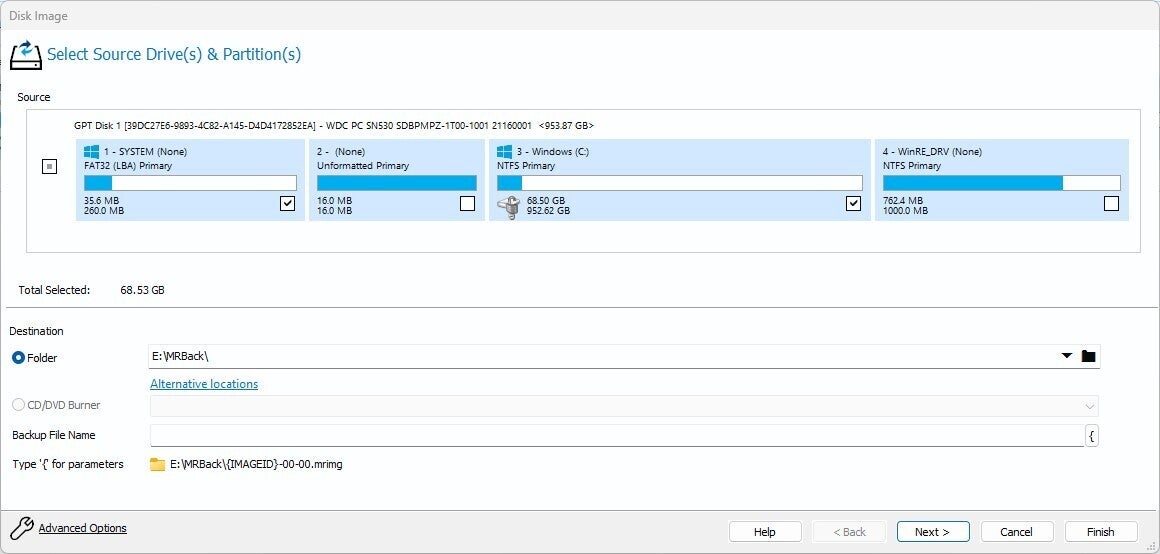 IDG
IDG 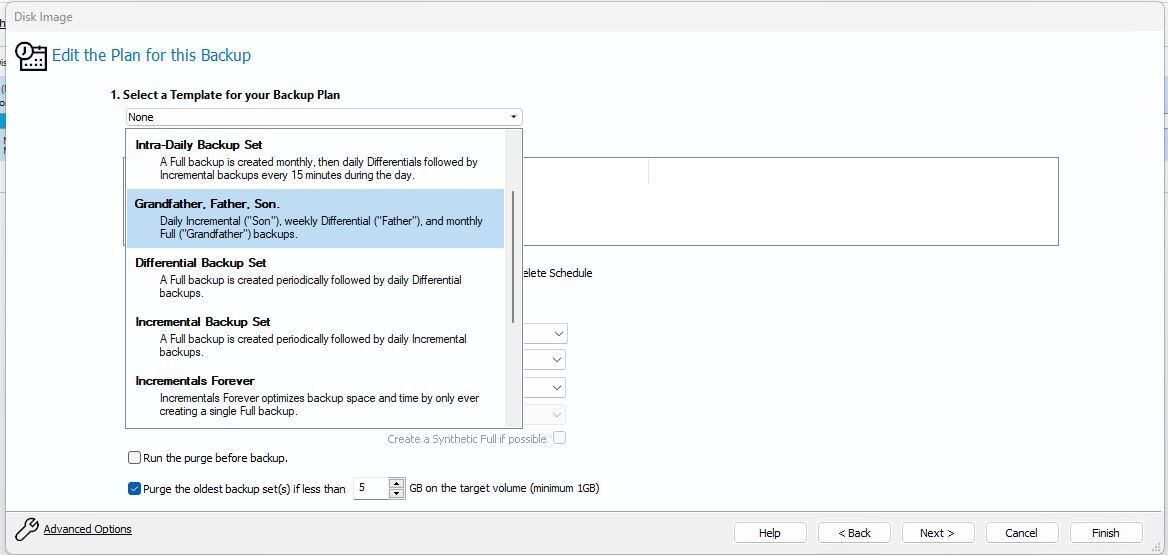 IDG
IDG 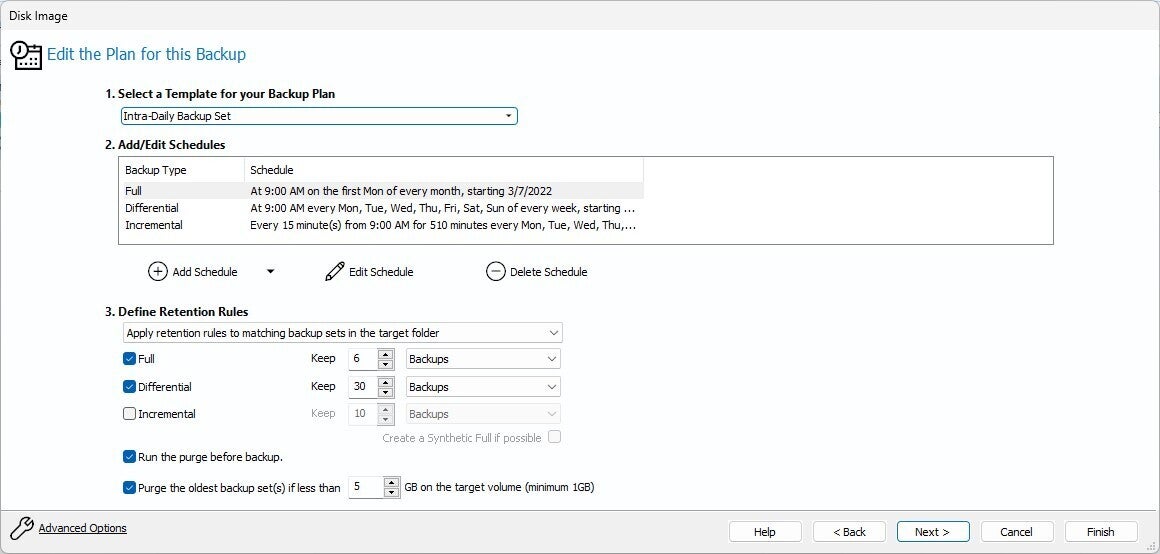 IDG
IDG 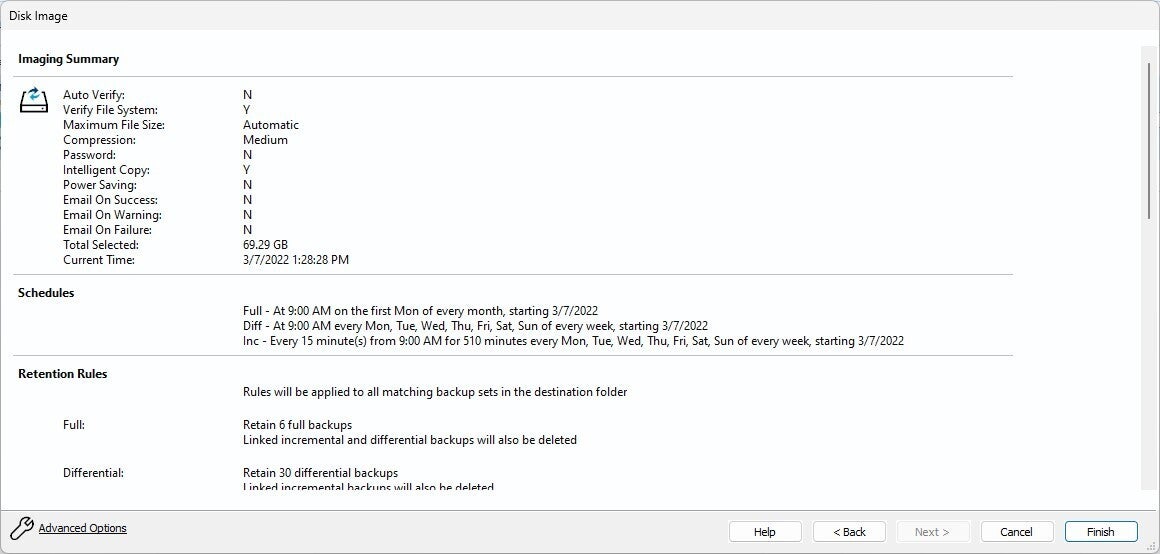 IDG
IDG 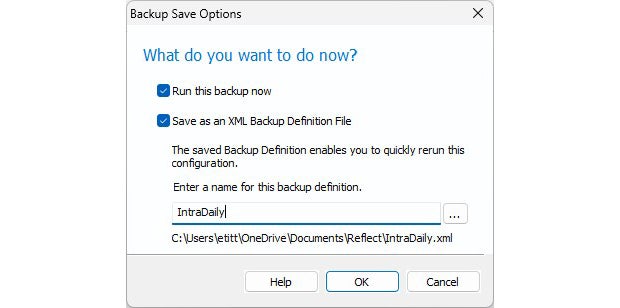 IDG
IDG 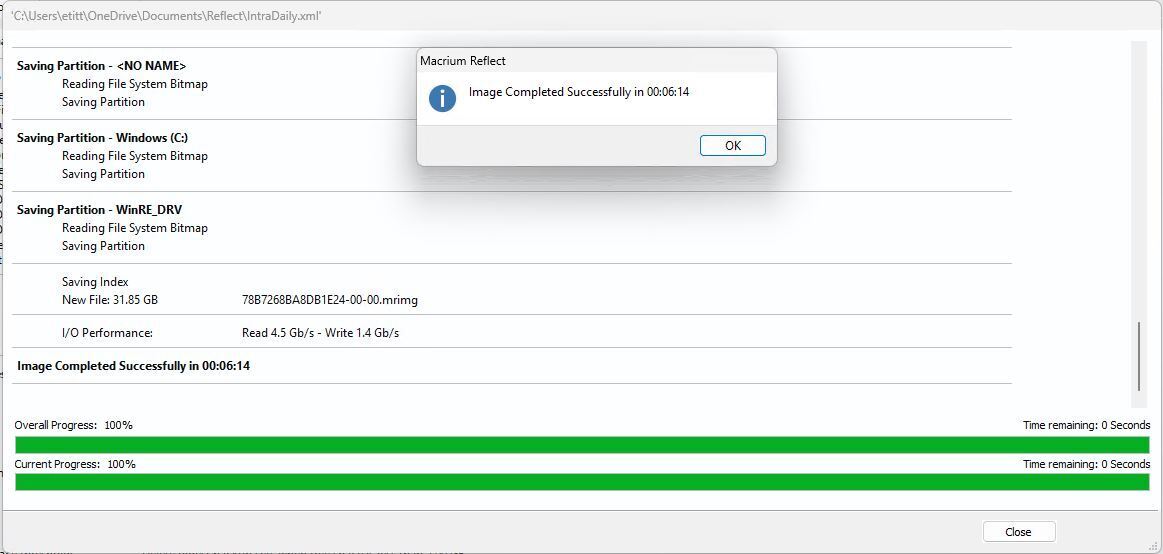 IDG
IDG Restore an image backup
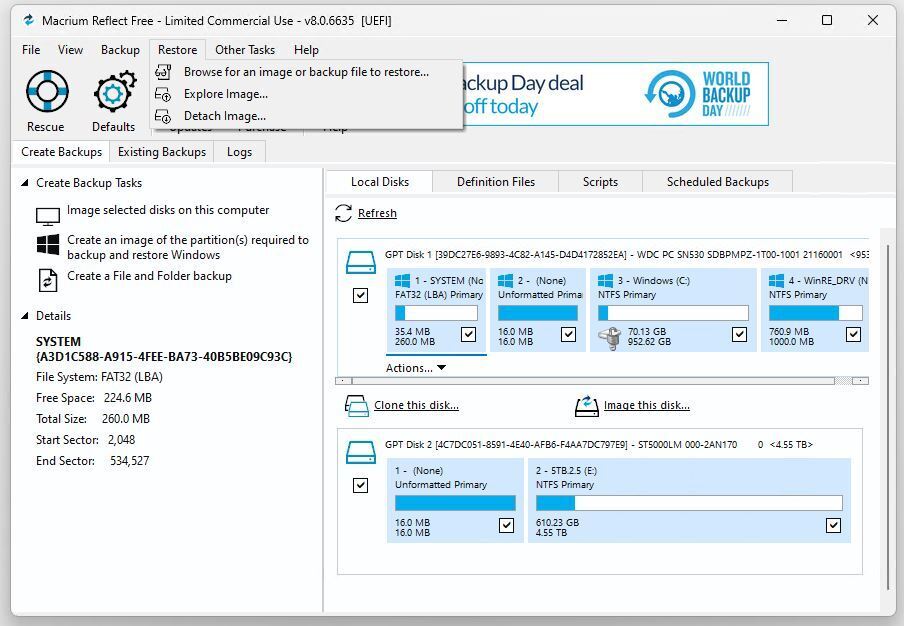 IDG
IDG 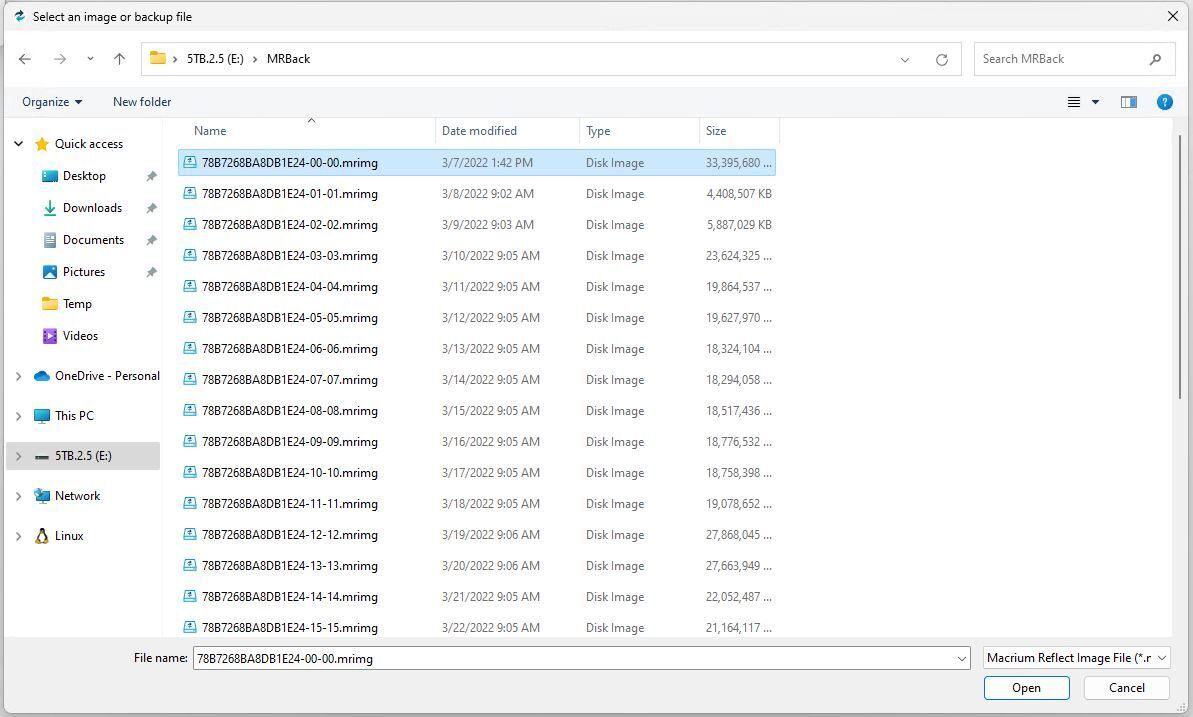 IDG
IDG Pick your backup, and use it to the max!
weekly@StateOfJeffersonRotary.org
![]()
New Science Reveals the Best Way to Take a Pill
By Adam Marcus
I want to tell you a story about forgetfulness and haste, and how the combination of the two can lead to frightening consequences. A few years ago, I was lying in bed about to turn out the light when I realized I'd forgotten to take "my pill."
Like some 161 million other American adults, I was then a consumer of a prescription medication. Being conscientious, I got up, retrieved said pill, and tossed it back. Being lazy, I didn't bother to grab a glass of water to help the thing go down. Instead, I promptly returned to bed, threw a pillow over my head, and prepared for sleep.
Within seconds, I began to feel a burning sensation in my chest. After about a minute, that burn became a crippling pain. Not wanting to alarm my wife, I went into the living room, where I spent the next 30 minutes doubled over in agony. Was I having a heart attack? I phoned my sister, a hospitalist in Texas. She advised me to take myself to the emergency room to get checked out.
If only I'd known then about "Duke." He could have told me how critical body posture is when people swallow pills.
Who's Duke?
Duke is a computer representation of a 34-year-old, anatomically normal human male created by computer scientists at the IT'IS Foundation, a nonprofit group based in Switzerland that works on a variety of projects in health care technology. Using Duke, Rajat Mittal, PhD, a professor of medicine at the Johns Hopkins School of Medicine in Baltimore, created a computer model called "StomachSim" to explore the process of digestion.
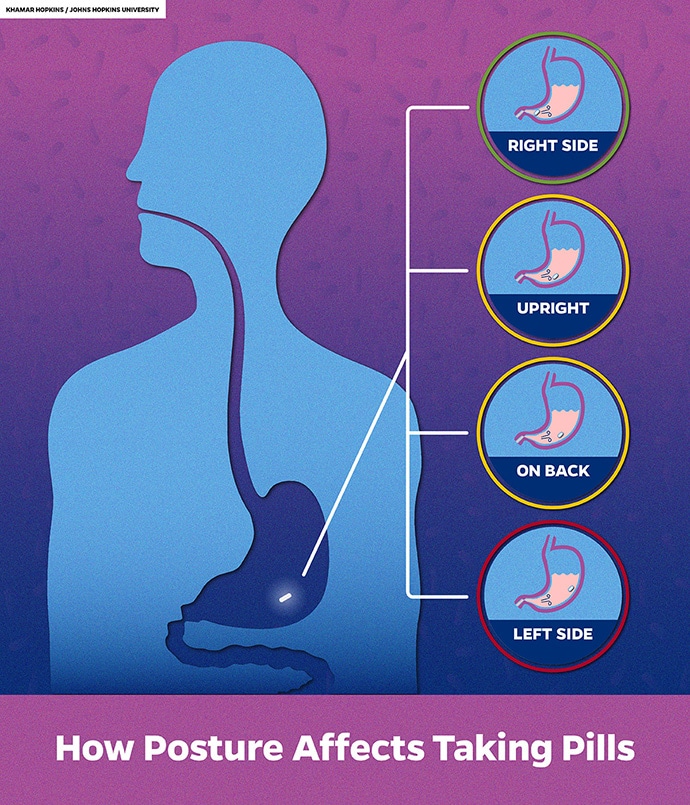
Their research, published in the journal Physics of Fluids , turned up several surprising findings about the dynamics of swallowing pills – the most common way medication is used worldwide.
Mittal says he chose to study the stomach because the functions of most other organ systems, from the heart to the brain, have already attracted plenty of attention from scientists.
"As I was looking to initiate research in some new directions, the implications of stomach biomechanics on important conditions such as diabetes, obesity, and gastroparesis became apparent to me," he says. "It was clear that bioengineering research in this arena lags other more 'sexy' areas such as cardiovascular flows by at least 20 years, and there seemed to be a great opportunity to do impactful work."
Your Posture May Help a Pill Work Better
Several well-known things affect a pill's ability to disperse its contents into the gut and be used by the body, such as the stomach's contents (a heavy breakfast, a mix of liquids like juice, milk, and coffee) and the motion of the organ's walls. But Mittal's group learned that Duke's posture also played a major role.
The researchers ran Duke through computer simulations in varying postures: upright, leaning right, leaning left, and leaning back, while keeping all the other parts of their analyses (like the things mentioned above) the same.
They found that posture determined as much as 83% of how quickly a pill disperses into the intestines. The most efficient position was leaning right. The least was leaning left, which prevented the pill from reaching the antrum, or bottom section of the stomach, and thus kept all but traces of the dissolved drug from entering the duodenum, where the stomach joins the small intestine. (Interestingly, Jews who observe Passover are advised to recline to the left during the meal as a symbol of freedom and leisure.)
That makes sense if you think about the stomach's shape, which looks kind of like a bean, curving from the left to the right side of the body. Because of gravity, your position will change where the pill lands.
In the end, the researchers found that posture can be as significant a factor in how a pill dissolves as gastroparesis, a condition in which the stomach loses the ability to empty properly.
How This Could Help People
Among the groups most likely to benefit from such studies, Mittal says, are the elderly – who both take a lot of pills and are more prone to trouble swallowing because of age-related changes in their esophagus – and the bedridden, who can't easily shift their posture. The findings may also lead to improvements in the ability to treat people with gastroparesis, a particular problem for people with diabetes.
Future studies with Duke and similar simulations will look at how the GI system digests proteins, carbohydrates, and fatty meals, Mittal says.
In the meantime, Mittal offers the following advice: "Standing or sitting upright after taking a pill is fine.If you have to take a pill lying down, stay on your back or on your right side. Avoid lying on your left side after taking a pill."
As for what happened to me, any gastroenterologist reading this has figured out that my condition was not heart-related. Instead, I likely was having a bout of pill esophagitis, irritation that can result from medications that aggravate the mucosa of the food tube. Although painful, esophagitis isn't life-threatening. After about an hour, the pain began to subside, and by the next morning I was fine, with only a faint ache in my chest to remind me of my earlier torment. (Researchers noted an increase in the condition early in the COVID-19 pandemic, linked to the antibiotic doxycycline.)
And, in the interest of accuracy, my pill problem began above the stomach. Nothing in the Hopkins research suggests that the alignment of the esophagus plays a role in how drugs disperse in the gut – unless, of course, it prevents those pills from reaching the stomach in the first place.
Sources
Rajat Mittal, PhD, professor of medicine, Johns Hopkins University School of Medicine; professor of mechanical engineering, Whiting School of Engineering.
Physics of Fluids: "Computational modeling of drug dissolution in the human stomach: Effects of posture and gastroparesis on drug bioavailability."


